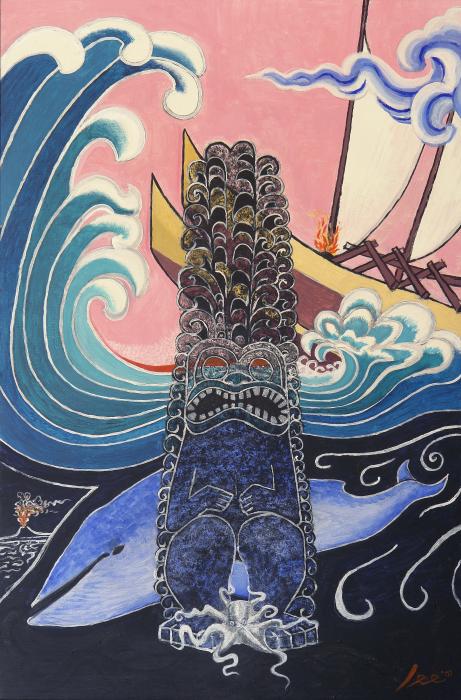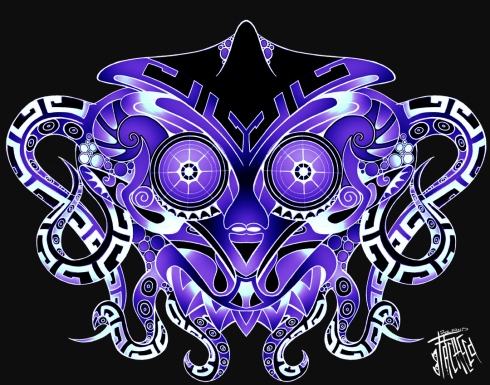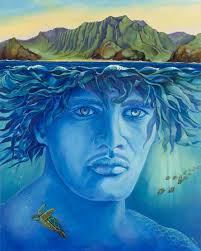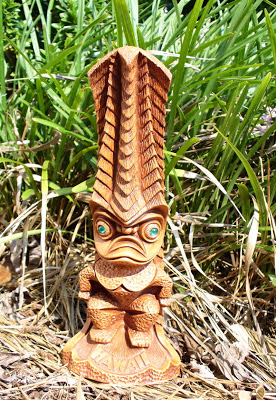You are currently browsing the tag archive for the ‘depths’ tag.

Africa’s Congo River is the 10th longest river on Earth, but it is the world’s second greatest river by volume of water discharged. In the final 300 kilometer (200 mile) span before the river empties into the Atlantic Ocean, the Congo is a deeply weird river…in that it is weirdly deep. Portions of the Lower Congo have a depth of 220 meters (720 feet) which makes the Congo the world’s deepest river (chasmic freshwater locations are evidently a fascination here at Ferrebeekeeper). The bottom of the Lower Congo is not a serene place either, but is a dark world of treacherous currents, strange eddies, underwater waterfalls, and whirlpools.

Although these depths do not sound like the ideal place for, say, opening a sandwich shop, they are ideal for expediting the speciation of fish. The Lower Congo has over 300 species of fish (and the number is growing as adventuresome ichthyologists study the native fish more closely…and as the river creates new varieties of fish). The fast currents act like mountain ranges do on land, separating genetic pools of certain species so that they evolve in different directions. This had led to some truly strange species such as the Gymnallabes nops (an air breathing catfish which is giving up on the scary river and crawling off into the moist leaves of the jungle), all sorts of exquisite elephant fish (Mormyridae) electrical fish which read the substrate with sensitive trunk like “noses”, upside-down polka-dotted squeaking catfish (which sounds like a rockabilly lyric), and, maybe best of all, Lamprologus lethops, a blind white cichlid of the chaotic depths which dies of decompression sickness when jerked up to the river’s surface. When seen by Congolese fishermen, this cichlid is a bony blob of quivering pale agony gasping from a bony mouth. This has led to the local folk calling it “Mondeli bureau” which means “white guy in an office” (an allusion to how they (correctly) imagine westerners look and feel in our miserable & pointless dayjobs).

This is exactly how I feel! Thanks for noticing, perceptive Congolese fisherfolk!
I wish I could tell you more about the wonders of the lower Congo, but research into this unique ecosystem has been surprisingly scant. I will keep my eyes open though. I want to know more about those upside-down, polka-dotted, screaming catfish! I also want to write more about catfish of the Gymnallabes family. Finally, I have a feeling there are even weirder fish at the very bottom of the river, we just don’t know about them yet. We will keep our eyes on the Congo. For the world’s second greatest river, we know a lot less than we should.


Furnace Edifice (Wayne Ferrebee, 2016, colored pencil and ink)
Here are two more funny drawings from my little book. The first is a drawing from February, when I can never get warm enough. A strange furnace edifice of ovens and stoves chugs away: its fires produce delightful heat. Two monsters have come to bask in the warmth (maybe the anglerfish is part of the mechanism for fueling the array). At the top an attendant pours water onto the furnaces to produce great clouds of steam. I am not sure if this is about cleanliness or energy or entrapment…or maybe all three.

The Cave Beneath the Icing (Wayne Ferrebee, 2016, colored pencil and ink)
In the next picture a glistening pink temple made of melting pink icing glistens above a purple cavern. In the depths of the cavern an addict grovels for drugs and medicine as an anglerfish lures him further down into the darkness. A glistening glazed doughnut sits in the middle of the composition as an avatar of appetite. Is this picture about illicit drugs or about legitimate medicine or about money? Does it matter?
In Finnish mythology, Iku-Turso was a malevolent ocean deity who took the form a terrible sea monster. Due to the vagaries of language, it is unclear whether he (?) had the shape of a colossal walrus or a giant terrible inkfish (i.e. an octopus). Contemporary Finnish artists apparently see no reason he can’t be both and the internet has some amazing and disturbing images of the dark god of the depths.
Not only was Iku-Turso’s appearance formidable, but he seemingly had powerful and weird magic—a sort of divine antagonistic surrealist. The god makes a typically bizarre appearance in the Kalevala, the great mythological epic of the Finns (which Ferrebeekeeper has already visited—to tell the dark story of Lemminkäinen and the Swan of Tuonela). In the second canto, the god rises from the depths and burns a huge hay stack. From the cinders grows an oak so large that it threatens to blot out the sun and moon—and so the tree must be cut down. Later in the epic, Inku-Turso is enlisted by the goddess of the North (the witch Louhi) to prevent the theft of the powerful magical artifact Sampo. However one of the sorcerers seeking Sampo was too powerful for even a bizarre walrus/octopus sea god to stop. Poor Inku-Tursu ended up magically cursed to haunt the bottom of the ocean.
The dark god has made few appearances since then, but I imagine a Finnish epic about exploring the abyssal plains would be exceedingly exciting! In fact that sounds great for all sorts of reasons! Could some of you Finnish bards get busy and make it happen?
 For poetry month in April I featured an intense excerpt from a moving spiritual poem by Lord Alfred Tennyson. Today has gotten away from me entirely….I just didn’t have enough arms to do everything I needed to do, much less write an intense literary essay. But do you know who does have more than enough arms–giant terrifying underwater squid monsters! Here is a Tennyson poem about the kraken, which may be a mythical Cthulhu-type monster…or may be an all-too-real colossal squid. It is from Tennyson’s juvenilia so he most likely wrote it as a gawky teenager (which is a funny image).
For poetry month in April I featured an intense excerpt from a moving spiritual poem by Lord Alfred Tennyson. Today has gotten away from me entirely….I just didn’t have enough arms to do everything I needed to do, much less write an intense literary essay. But do you know who does have more than enough arms–giant terrifying underwater squid monsters! Here is a Tennyson poem about the kraken, which may be a mythical Cthulhu-type monster…or may be an all-too-real colossal squid. It is from Tennyson’s juvenilia so he most likely wrote it as a gawky teenager (which is a funny image).
Whatever the case, it is an amazing and eerie poem which beautifully evokes the overripe and otherworldy horrors of the unknown depths and then imagines the poor kraken being dragged to a burning operatic end on judgement day! Whoah!
Here is the poem! Enjoy!
The Kraken (from Tennyson’s “Juvenilia” published 1871 and on)
Below the thunders of the upper deep; Far, far beneath in the abysmal sea, His antient, dreamless, uninvaded sleep The Kraken sleepeth: faintest sunlights flee About his shadowy sides: above him swell Huge sponges of millennial growth and height; And far away into the sickly light, From many a wondrous grot and secret cell Unnumber'd and enormous polypi Winnow with giant arms the slumbering green. There hath he lain for ages and will lie Battening upon huge seaworms in his sleep, Until the latter fire shall heat the deep; Then once by man and angels to be seen, In roaring he shall rise and on the surface die.
In all of entertainment, no figure is more beloved than Opah! Her networks make the most money. Her endorsements confer instant fame and wealth. Her personal life is the subject of profound fascination and scrutiny. She is what all Americans aspire to be…a veritable queen who transcends…
Wait…Opah? That’s a big orange fish! Also known as moonfish, opahs consist of two species (Lampris guttatus and Lampris immaculates) which are alone in their own small family the Lampridae. Their closest relatives are the magnificent ribbonfishes like the crestfishes and oarfish! They are discoid fish with orange bodies (speckled with white) and with bright vermillion fins. Opahs do not give away cars or support quack psychiatrists and physicians, but, they are much in the news right now anyway. To the immense surprise of ichthyologists and zoologists, a research team from the NOOA has discovered that Opahs are warm-blooded—in a way. They are the only endothermic fish known to science.
Being warm-blooded allows animals in the deep ocean to think and move more swiftly than the more ascetic and staid dwellers of the deep (most creatures of the ocean bottom are usually slow and placid in order to conserve energy–like the tripod fish). Ocean birds and marine mammals have long used this to their advantage. They gulp air from the surface and then dive deep to catch slower moving fish, squid, and invertebrates from the cold depths.
Other high-speed predatory fish (certain species of sharks and sportsfish) can warm key muscle groups using heat exchanging blood vessels in order to gain a burst of super speed, but these fish rapidly lose their heat—and the related speed advantages–as their blood circulates through their gills. This is one of the reasons sharks and marlins lunge and then return to slow measured swimming.
The opah appears to produce the majority of its heat by constantly flapping its pectoral fins. The warmth thus generated is not lost through the opahs’ gills. Critically, these fish possess unique insulated networks of blood vessels between their hearts and gills. The residual heat is removed from blood headed through the gills and then restored as it goes back through the heart. Their weird circular shape and comparatively large size are additional adaptations to help them conserve this warmth.
Marine biologists know surprisingly little about opahs (especially considering that the fish have long been known to fishermen and diners). Opahs live in the mesopelagic depths 50 to 500 meters (175 to 1650 feet) beneath the surface but it now seems they might make deeper hunting forays into the true depths. They are solitary hunters which live on shrimp, krill, and small fish. Opahs are approximately the size of vehicle tires. The smaller species (Lampris immaculatus) is like a big car tire and reaches a maximum of 1.1 m (3.6 ft). The larger species, Lampris guttatus, can become as large as an industrial lorry tire and can attain a length of 2 m (6.6 ft). the largest opahs weight up to 270 kg (600 lb).
Larval opahs resemble the larvae of oarfish (they are long and ribbonlike with strange protuberances. The main predators of Opahs are the great sharks…and humankind. Because of predation from this latter species which is endlessly hungry the survival of the opahs has grown less certain. It is believed that they have a low population resilience, but this…like their numbers and their lifestyle is unknown to science. We only just found they were warm-blooded earlier this month!
In Hawaiian mythology the most important deity was the beneficent creator god Kāne, the deity of the sun, the dawn, and the fertile forests where people liked to dwell. Yet there was also a deity in opposition to Kāne—an evil god of the dark depths of the ocean, and darkness, and the death of all things. This underworld deity was known as Kanaloa and was sometimes envisioned as a black, poisonous squid or octopus.
The Hawaiian myth of creation involves an art contest of sorts between Kāne and Kanaloa: both deities carved human beings out of basalt but only Kane’s man and woman came to life. Kanaloa’s people remained dark stone. In anger, Kanaloa seduced the first man’s wife and brought enmity between the sexes. The dark deity then invented poison and thus caused many fish, plants, and animals to be injurious to the new humans. Still not satisfied he crafted death so that men and women would have only a short time in the world.
Because of his mischief, Kanaloa was banished to the depths of the ocean, but he retained his power and godhood. Sailors and fishermen pray to Kanaloa so as to remain safe when crossing his watery domain. Likewise he is worshipped as the foremost god of magic. I wish I had some good stories about Kanaloa doing interesting things while in his octopus form, but sadly stories of the dark god are rare. Some ethnologists even suggest that his role was altered and stories about the deity were changed so that he would fit more coherently into missionaries’ stories about God and the Devil.

















